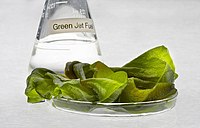
Photo from wikipedia
The objective of the study was to evaluate the potential application of defatted algal biomass (DAB) residue as a resource for biobased product synthesis in the biorefinery framework. Acid-catalyzed pretreatment… Click to show full abstract
The objective of the study was to evaluate the potential application of defatted algal biomass (DAB) residue as a resource for biobased product synthesis in the biorefinery framework. Acid-catalyzed pretreatment of DAB residue resulted in higher reducing sugars (RS) solubilization (0.26 g RS/g DAB) than corresponding base method (0.19 g RS/g DAB). Subsequently, resulting RS were acidogenically fermented for the production of Bio-H2 and short chain carboxylic acids (SCA)/volatile fatty acids (VFA) at varying redox conditions (pH: 6, 7 and 10). Biosystem with pH-6 resulted in higher SCA (0.54 g SCA/g RS) and Bio-H2 production (0.83 l) followed by pH-10 (0.43 g SCA/g RS, 0.71 l) and pH-7 (0.27 g SCA/g RS, 0.48 l). Higher SCA production in pH-6 system resulted in maximum acidification (23%). Algal biomass majorly derived from CO2 and its residues after lipids extraction accounted as major feedstock for acidogenic product synthesis. Evaluation of these studies using DAB residues offers sustainability to algal refineries on its entirety use.
Journal Title: Bioresource technology
Year Published: 2018
Link to full text (if available)
Share on Social Media: Sign Up to like & get
recommendations!